A s I prepare to send my kids back to school, I’m mentally making a list of tasks that I need to get done as the new school year approaches. If you’re a parent of a child through adoption, your list likely has additional tasks other than just buying school supplies, books, and clothes for the new school year. Each year my children have to start over again, with a new teacher and new classmates, and this task alone can be difficult, but when you add adoption into the mix it complicates the transition even further. Then if the teacher is not familiar with adoption, it can make things particularly difficult, especially in the beginning. When my child starts school she will likely have to re-answer many of those tough questions with new peers and a new teacher about her birth family or where she was born. I try to be proactive to try to help my child have the best start to the school year.
s I prepare to send my kids back to school, I’m mentally making a list of tasks that I need to get done as the new school year approaches. If you’re a parent of a child through adoption, your list likely has additional tasks other than just buying school supplies, books, and clothes for the new school year. Each year my children have to start over again, with a new teacher and new classmates, and this task alone can be difficult, but when you add adoption into the mix it complicates the transition even further. Then if the teacher is not familiar with adoption, it can make things particularly difficult, especially in the beginning. When my child starts school she will likely have to re-answer many of those tough questions with new peers and a new teacher about her birth family or where she was born. I try to be proactive to try to help my child have the best start to the school year.
Here are some back-to-school tasks for adoptive parents:
- Write a letter: Here is a sample letter you can edit and send to your child’s teacher. https://mljadoptions.com/blog/dear-teacher-a-sample-letter-20130717
- Schedule a parent/teacher conference: Teachers shouldn’t be blindsided by behaviors that they may experience from your child the first day or week of school. Give them a heads-up and tips for dealing with specific behaviors. If your child has specific triggers such as loud noises, violence, being left alone, food or holidays, let your teacher know how best to handle those topics. Parents need to keep in mind that their child’s story is private and personal and that information should only be shared if it is significant to their child’s daily care or education.
- Provide adoption resources for teachers: Resources might include children’s books like It’s Okay To Be Different by Todd Parr, A Mother for Choco, by Keiko Kasza, or Rosie’s Family: An Adoption S
tory by Lori Rosove. You can also recommend books to help teachers understand more about trauma and adoption like Help for Billy by Heather Forbes, or The Connected Child by Karyn Purvis, David Cross and Wendy Sunshine. - Prepare for difficult assignments: Provide information on how and why to rethink certain assignments that may be difficult for children who were adopted. Typical class assignments that require baby photos or family tree exercises may be problematic for children who joined their family through adoption. These assignments can be easily adapted to still meet requirements and accommodate children with different histories.
- Raise racial awareness: There is no such thing as being “color-blind”. Even children are aware of racial differences at an early age. Books like The Sneeches by Dr. Seuss along with a good anti-racism classroom activity can help promote racial awareness. As a parent of a child of color I want to know that my child’s teacher understands racial discrimination and what it looks like in the classroom. Teachers should enforce a zero-tolerance policy and take action to educate students early on to have a positive and knowledgeable racial identity. Bring in your child’s favorite food, dress-up clothes, or music from your child’s culture of origin to share with the class.
- Review tough questions: There will always be tough questions in new beginnings, especially with new classmates or a new school. Before school starts, it’s important to review with your child how to answer questions she may be asked. The Wise Up! Powerbook is a great resource to use with children to help them learn how to answer tough questions. This book teaches children that their story is personal and unique and they can choose how and when to share it.
- Evaluate Education Plan: Determine if any changes or adjustments need to be made to the child’s current education plan, and discuss progress or changes that have occurred with your child over the summer.
- Get involved: Find ways to get involved at your child’s school, like volunteering in the classroom, chaperoning field trips, donating supplies, attending PTO meetings, offering to talk to your student’s class about adoption, or sending teachers information on upcoming training sessions.
Unfortunately, not all of these tasks may be completed before the start of school, but they’re important to keep in mind throughout the school year. Many of these tasks are ongoing and may require re-visiting several times. For example, when the child on the playground makes your daughter cry because he tells her that her “real” parents didn’t care about her, or when there’s a fire drill at school and your child was not prepared in advance and takes off running at the sound of the alarm. I try not to be a helicopter parent, but I have to stay involved and keep open communication with those in charge of caring for my child daily. Adoptive parenting requires that we not only educate ourselves but that we also educate others around us, and advocate for our children when needed.

